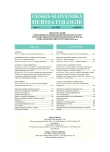Contact Sensitization to Selected Adjuvants in Dermatologic Topical Medications and Cosmetics in Relation to Eczema Localization
Authors:
E. Dastychová; M. Nečas; K. Pěnčíková
Authors‘ workplace:
I. dermatovenerologická klinika LF MU a FN U sv. Anny v Brně
přednosta doc. MUDr. Vladimír Vašků, CSc.
Published in:
Čes-slov Derm, 80, 2005, No. 5, p. 270-275
Category:
Clinical and laboratory Research
Overview
The frequency of contact sensitivity to 28 selective additives of topical dermatologic medications and cosmetics in a group of nine hundred patients with chronic eczema (289 males, 611 females, mean age 43,6 years) was evaluated in relation to eczema localization. In patients with face and neck eczema (n 350) lanolin alcohols (4,3%), bronopol (3,7%), dibromdicyanobutan/phenoxyethanol (2,9%), imidazolidinylurea (2,9%), chlorhexidinegluconate (2,3%), diazolidinylurea (2,3%) and Kathon CG (2%) were the most important contact allergens.
In eczema localized on hands and forearms (n 504) the most important allergen was formaldehyde (3,8%), lanolin alcohols (3%), dibromdicyanobutan/phenoxyethanol (2,8%), bronopol, chloracetamide and Kathon CG (2,4%), and diazolidinylurea (2,2%).
In eczema localized on feet and legs (n 188) the sensitization to lanolin alcohols (12,8%), paraben mix (4,8%), formaldehyde (2,7%) and chloracetamide (2,1%) was detected.
(In some patients more areas were involved.)
In the group of women with face eczema the percentage of allergic reactions was statistically significantly higher (p<0,05) in comparison with the group of men (Fischer exact test).
Key words:
contact sensitivity – dermatologic topical medications – cosmetics – adjuvants – preservatives – antioxidants
Labels
Dermatology & STDs Paediatric dermatology & STDsArticle was published in
Czech-Slovak Dermatology

2005 Issue 5
Most read in this issue
- Contact Dermatitis
- Seborrheic Dermatitis
- Incidence Monitoring of Contact Sensitization to Selected Adjuvants in Dermatologic Topical Medications and Cosmetics in Patients with Eczema – Results and Conclusions of a grant project
- Contact Sensitization to Selected Adjuvants in Dermatologic Topical Medications and Cosmetics in Relation to Eczema Localization
